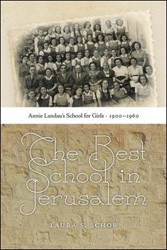Naomi Prawer Kadar grew up in the world of secular Jewish culture; undoubtedly this book, published posthumously, was a labor of love. Her parents were Polish Holocaust survivors who settled in the Bronx after World War II. They had been members of Poalei Tzion, the workers’ Zionist movement, and their daughter carried on their passion for Yiddish and Hebrew. She attended a Sholem Aleichem Folkshul and a United Mitelshul high school. In college, she spent her junior year in Israel, where she met her husband. Returning to America, she became the national director of the Workmen’s Circle Yiddish schools, taught Yiddish at Columbia University and the Jewish Theological Seminary, and earned a PhD in Yiddish literature at Columbia.
Raising Secular Jews is a revised version of Kadar’s dissertation. Professor David G. Roskies, the prominent Yiddish scholar and Kadar’s dissertation director, contributed a valuable six-page introduction which noted that Kadar had documented the attempt to create and sustain a secular identity for American Jews at a time when “there was hope that Yiddish and Yiddishkeit would became a basic part of their identity and would permanently enrich their sense of being human.”
Raising Secular Jews is a detailed, well-crafted, and perceptive history of the eight children’s magazines used in the Yiddish schools. The author’s discussion of the art work and literature in the magazines is particularly insightful. These magazines reflected the ideologies of the organizations that founded them, and much of Raising Secular Jews discusses their oftentimes bitter rivalries. The Farband schools were socialist and Zionist in orientation; the Sholem Aleichem schools were apolitical and “free thinking”; the Workmen’s Circle schools espoused socialism and opposed Zionism; and the Ordn schools of the International Workers Order championed communism. And yet, despite these ideological differences, all of the Yiddishists believed they were on the verge of a new world order, and that the preservation and propagation of the Yiddish language through their schools and magazines would help bring this about.
It is precisely this spirit of hopefulness which makes reading Raising Secular Jews so poignant. By 1950, the terminus of the book, it was clear that secular Yiddish culture in America was doomed. The founding of the state of Israel and the resurgence of Hebrew as “the” Jewish language, the federal government’s restriction of immigration from eastern Europe, the decimation of East European Jewry during World War II, the competition of synagogue congregational schools teaching Hebrew, the rapid acculturation of Jewish immigrants and their progeny, and the massive postwar migration of Jews to suburbia resulted in a precipitous decline in the number of Yiddish schools and their students. In addition, the ideologies of the schools themselves helped to spell their doom.
Most proponents of secular Yiddish culture, including Kadar’s own parents, were socialists of one sort or another, but socialism has always been on the fringes of mainstream American politics. At the heyday of East European Jewish immigration to America in the early twentieth century, the German sociologist Werner Sombart published his book Why Is there No Socialism in America (1906), and by 1950 America had become even more inhospitable to socialism and socialists. Why the Yiddishists could have believed that the socialism they had dreamed about in Europe could be a viable political option in a country where the very word “socialism” was a term of opprobrium remains a mystery.
The same could be said of the Yiddishists’ fervent opposition to religion in general and Jewish Orthodoxy in particular. Religion has always been highly respected in America, even by the non-religious, and throughout the twentieth century America was the most religious of the advanced industrial countries. The most ironic aspect in the history of American Yiddish schools was their simultaneous decline and the growth of Yiddish religious schools. The most important contemporary bastions of the Yiddish language are right-wing Orthodox enclaves in New York and New Jersey, which represent everything the Yiddishists loathed.
Finally there is the matter of language. Despite the efforts of the Yiddish Book Center in Massachusetts, various university courses in Yiddish, and other valiant attempts to preserve and popularize Yiddish, the language is not a lingua franca except within the right-wing Orthodox world, and even here its long-term future is not promising. The secular Yiddish theater, radio stations, movies, magazine and newspapers, and schools have disappeared or are on life support. The Yiddish of the home could never compete with the English of the public school, the street, or the playground.
Kadar’s last chapter, “Almost at Home in America,” examines how the Yiddish schools and summer camps responded to the rapid acculturation of Jewish immigrants and their children Jews during the 1930s and 1940s. On the one hand, their leaders saw “the possibility of pursuing an autonomous Jewish life” while “achieving the American dream,” and they were grateful for the “security and comfort” they enjoyed as Americans, particularly when contrasted with what was occurring to Jews in Europe. But on the other hand, they realized that they “were witnessing the beginning of the end of spoken Yiddish.” Kadar concludes that “walking the tightrope of becoming integrated into American society while maintaining a close connection to the Jewish roots and linguistic heritage of the immigrant generation ultimately proved to be an impossible task.” America’s Yiddish schools proved to be a two-generation phenomenon. Raising Secular Jews would have been an even better book if it had explained why the founders of these schools ever believed they could create a thriving secular and left-wing Jewish culture in America in the first place.



